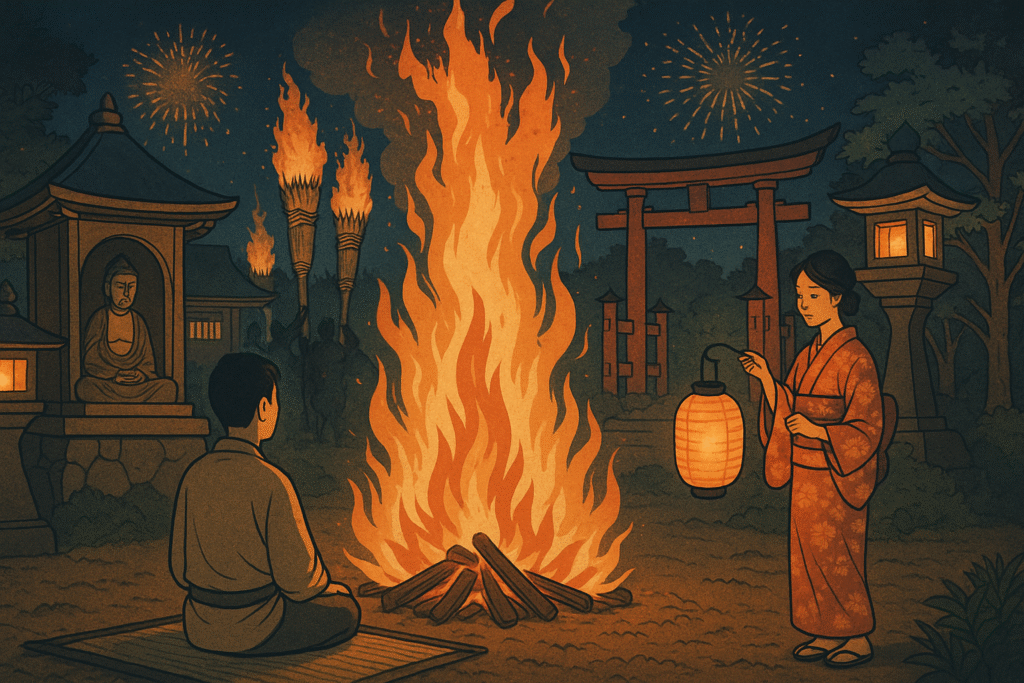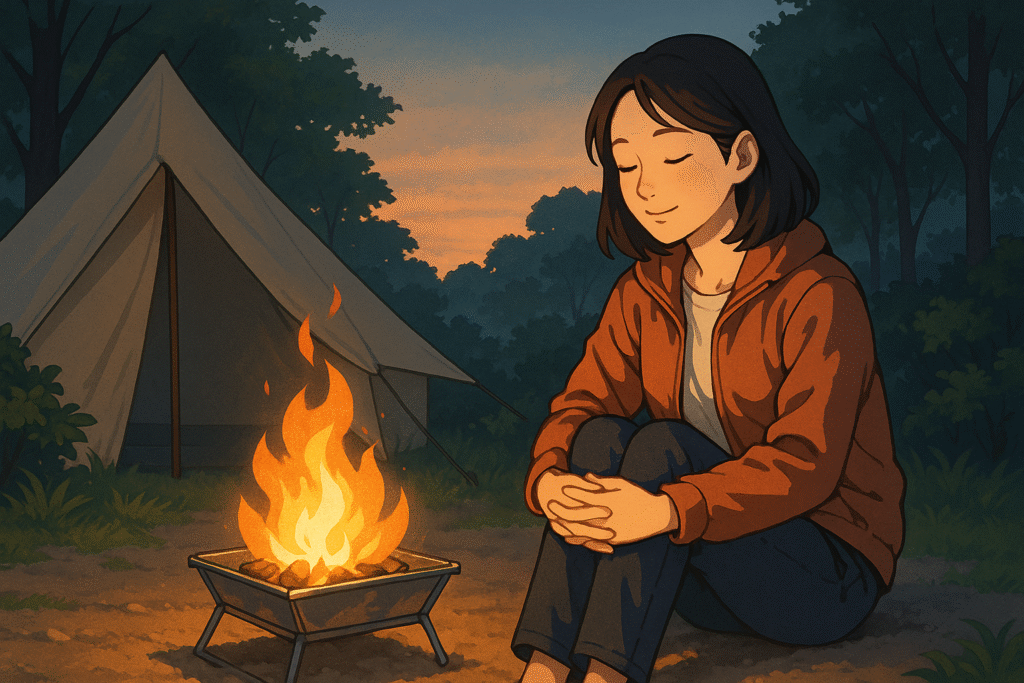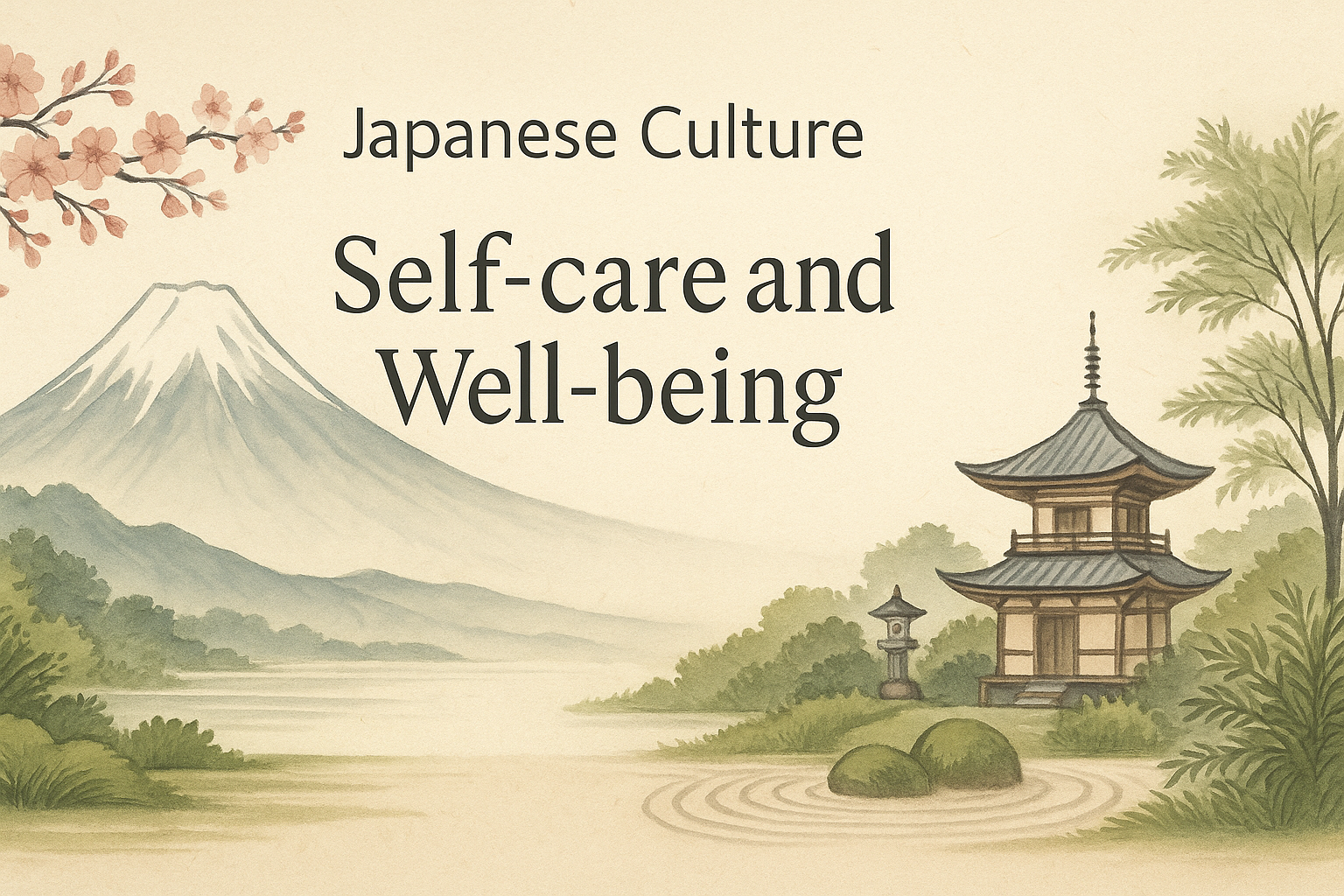Looking for a simple yet meaningful way to reset after work in Japan? While not widespread, some Japanese professionals are embracing solo fire gazing as a modern way to find peace and reconnect with nature. Rooted in cultural traditions of respect for fire and quiet reflection, this practice offers valuable insights for anyone seeking mindful stress relief. (Related article in Japanese)
- Japanese cultural background and fire traditions
- Solo fire gazing in modern Japan: A growing trend
- Tips for foreigners: How to enjoy fire gazing in Japan
- A story: How one Japanese professional resets after work
- Practical tips for mindful solo camping in Japan
- Conclusion: A peaceful modern practice rooted in tradition
Japanese cultural background and fire traditions
Fire has held a profound place in Japanese culture and daily life for centuries, intertwining spiritual, practical, and aesthetic dimensions.
In Shinto, Japan’s indigenous belief system, fire (hi) is seen as a pure force capable of cleansing both body and spirit. Sacred fires are used in rituals to purify spaces, invite divine presence, and mark life transitions. For example, during Oniyo, one of Japan’s oldest fire festivals, massive torches are paraded to ward off evil and pray for good fortune.
In Buddhism, the goma fire ritual involves burning wooden sticks inscribed with prayers and negative attachments, symbolizing spiritual purification and release from worldly desires.
Beyond formal religious ceremonies, fire has shaped everyday life in Japan for generations. The irori, a sunken hearth found in traditional Japanese homes, served as a gathering place for families — not merely for warmth or cooking, but as a focal point for conversation, storytelling, and quiet reflection. The rhythm of life around the irori was closely tied to seasonal changes and the cycles of nature.

Even today, remnants of this fire-centered cultural sensibility persist:
- Lanterns at temples and shrines that softly illuminate pathways, inviting contemplation
- Bonfires at summer festivals, bringing communities together under the night sky
- Hanabi (fireworks) displays, which evoke a fleeting, bittersweet beauty (mono no aware) — a uniquely Japanese appreciation of impermanence
In modern homes, charcoal grilling and small garden bonfires echo this deep-rooted relationship between fire and communal or personal space.
Importantly, fire in Japanese culture is not merely functional or decorative; it embodies a philosophy of transience, warmth, and renewal. Its light and movement invite introspection and a gentle slowing down — qualities deeply valued in a society where harmony with nature has long been considered essential to well-being.
This rich cultural context helps explain why, even today, some Japanese professionals find comfort in quietly sitting by a fire. For them, fire gazing is not an escape from modern life but a return — however briefly — to timeless rhythms of nature and reflection.
Solo fire gazing in modern Japan: A growing trend
While not a widespread habit, solo fire gazing is quietly gaining popularity among urban professionals seeking calm after demanding workdays. This subtle trend reflects Japan’s larger solo camping boom (soro kyanpu), which has grown significantly in recent years — fueled by busy lifestyles, crowded cities, and a cultural preference for introspective, independent pastimes.
Traditionally, a campfire (kampufaia) was a communal experience, symbolizing togetherness and shared stories. But today, an increasing number of individuals in Japan are discovering the therapeutic benefits of sitting alone with a small fire. For them, this is not about outdoor adventure or conquering nature, but about creating a mental and emotional pause — a rare chance to step away from roles, expectations, and digital noise.
This shift also mirrors broader societal trends:
- The growing appeal of slow, minimalist living
- The pursuit of “self-care” rooted in quiet reflection rather than active leisure
- A desire for places where one can feel unseen and unjudged, even if only briefly
Many who practice solo fire gazing do so in small municipal parks or campsites on weekday evenings, taking advantage of locations that allow small bonfires without requiring elaborate preparation or extended time away from work and family.
Though still a niche activity, solo fire gazing speaks to a deeper undercurrent in Japanese society — one that values not just escape, but the creation of quiet, personal spaces where reflection can occur naturally and without performance.

Tips for foreigners: How to enjoy fire gazing in Japan
If you’re a foreign resident or visitor in Japan and interested in trying this peaceful practice:
- 🔹 Find a legal spot for bonfires: Many municipalities have forest parks or campsites where small fires are allowed.
- 🔹 Respect Japanese etiquette: Keep noise down, clean up carefully, and view this as quiet time for reflection — not as a party.
- 🔹 Keep it simple: A basic fire pit, a quiet corner, and 30 minutes of your time can provide surprising mental clarity.
A story: How one Japanese professional resets after work
One Wednesday at 7:15 p.m., R-san, a professional woman in her 30s, quietly left her office after her design proposal was dismissed with a casual, age-related comment. Outwardly she smiled as usual; inwardly she felt a swirl of irritation and self-doubt.
Rather than dwell on it, she drove to a small city-run campsite with her trusty Uniflame Fire Grill Solo stored in her van.
At first, her mind was racing: unanswered emails, tense meetings replayed, critical comments lingering. But as the fire crackled and the night air cooled her skin, something shifted.
After about 20 minutes, she felt herself relax:
“The fire doesn’t care about age or opinions,” she thought. “Watching it, I can stop proving myself. I can just be.”
This simple ritual wasn’t an escape for R-san — it was a return to her natural rhythm, a personal pause after a demanding day.
Practical tips for mindful solo camping in Japan
For those interested in trying solo fire gazing while living in or visiting Japan, a few thoughtful preparations can make the experience smoother and more rewarding. Whether you’re seeking a short after-work escape or a weekend retreat, simplicity and mindfulness are key.
Here are some practical tips to help you enjoy this peaceful practice safely and comfortably:
🔹 Choose the right fire pit: Compact, foldable stainless steel fire pits like the Uniflame Fire Grill Solo are ideal for quick outings.
🔹 Short nature immersion works: 30–60 minutes in a forest setting can help reduce stress and improve mood, similar to Japan’s shinrin-yoku (forest bathing) practice.
🔹 Post-fire care: Use moisturizing skincare and aromatic oils after a bonfire to feel refreshed the next day — a tip many Japanese follow.
🔹 Prepare a “mobile base”: Keeping essential gear pre-packed in your car makes spontaneous evening escapes easier.
🔹 Embrace mindfulness: Solo fire gazing is about simplicity and presence, not about gear or performance. Approach it quietly and intentionally.

Conclusion: A peaceful modern practice rooted in tradition
Solo fire gazing after work isn’t a widespread or formal tradition in Japan — rather, it’s an emerging, personal way for some individuals to reconnect with themselves amid busy urban life.
Yet this quiet practice resonates with cultural sensibilities long present in Japan: a deep respect for fire as a symbol of purification and renewal, a love of nature’s rhythms, and an appreciation for moments of reflection away from societal expectations.
For visitors, residents, or anyone inspired by Japanese culture, solo fire gazing offers more than relaxation. It provides a glimpse into how ancient traditions and modern lifestyles quietly coexist here — and how even brief, simple rituals can restore balance and well-being.
Why not try creating your own quiet space, wherever you are, to pause, reflect, and reconnect — following the gentle example of those who sit quietly before a fire in Japan today?



Comments